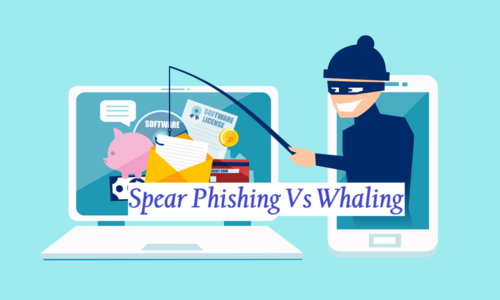Cybersecurity threats are actions taken by a person with malicious intent to steal data, hinder computing systems, or disrupt operations. Both Spear Phishing and Whaling are cybersecurity threats that use deception to penetrate companies and steal sensitive data. Despite the fact that they both belong under the broader category of phishing assaults, both techniques have quite different targets and operating systems. Spear Phishing targets a specific group of people. Whaling targets top officials of an organization. So, it is crucial to comprehend how these concepts differ. This helps individuals and organizations better defend themselves against cyber threats.

Jump ahead to
Spear Phishing
Spear Phishing is a subclass of phishing assaults in which the victim is particularly positioned to carry out the attacker’s intended outcome. It is a kind of phishing assault that targets a particular individual or business. By tricking the victim into opening malicious links or downloading malicious software, the attacker can access the target machine or network and take any sensitive data with them.
An organization or an individual will get a tailored email in a Spear Phishing assault. A malicious link disguised as legal is used to deceive the user into clicking on it. The attacker takes any personal information, including login passwords, credit and debit card information, and other sensitive information, when the user clicks on the link and enters their information.
Whaling
Whaling is a subcategory of Spear Phishing in which the attacker targets high-level employees, public figures, celebrities, and other high-profile people to get access to information or money. The attacker sends an email containing a malicious link that appears to be from a reliable source. These are carefully designed, precisely phrased, and are entirely real from all perspectives.
Critical business concerns are included in whaling emails, which are always addressed individually to the recipients by name and position. A successful whaling assault may cost a business thousands of money since the targets are in positions of power with minimal checks and balances.
Difference between Spear Phishing and Whaling
Spear Phishing and Whaling are two distinct forms of phishing attacks. The following are some key differences between these two attacks.
Knowledge of the Victim’s Identity
The attackers in Spear Phishing and Whaling know the victim’s identity. However, the perpetrators of whaling attacks are aware of each victim specifically and personally. They use this knowledge to make the threat more potent and fool the target into believing they are a trustworthy party. In Spear Phishing, perpetrators know only a few details about the victim’s identification.
Aim of Attack
The main objective of Spear Phishing is to trick the victim into doing particular behaviors, such as clicking on harmful links, downloading infected files, or disclosing sensitive information. The goal of a whaling assault is to deceive executives into taking actions that might lead to significant financial losses, the compromise of sensitive information, or a security breach at the company. Unlike Spear phishing, which needs several victims to fall for the campaign, a single successful whaling assault can aid hackers in achieving their malicious goals.
Level of Privilege and the Number of Primary Targets
Whaling and Spear Phishing differ significantly in this area. Although both target very privileged users, whaling targets have considerably more authority. It includes access to organizational funds, decision-making processes, national secrets, intellectual property, consumer data, banking rights, and many more. Spear phishing frequently happens at random when there are many victims. Although victims may provide valuable information or money compared to whaling targets, their privilege level is still low.
Use of Business Email Compromise
Business email compromise (BEC), also known as man-in-the-email scams. It is deceiving victims by utilizing email IDs of database administrators that are publicly available. BEC is a common phishing tactic used in whaling operations, especially CEO fraud, in which the fraudster assumes the identity of a C-level executive from the target company. Less BEC is used in spear phishing, and more harmful email attachments, fraudulent links, and fake user login pages are used.
Consequences
Successful whaling attempts typically cost far more than spear phishing attempts. Spear Phishing targets people with lower rights, so hackers get low payoff. The CEO, COO, and other top executives are trained on cybersecurity best practices, and a successful whaling campaign implies apparent competence somewhere.
Spear Phishing vs. Whaling
| Key | Spear Phishing | Whaling |
| Target | It targets a specific group of people or organization. | It targets top officials of an organization. |
| Aim | To steal sensitive information. | To steal admin credentials or trade secrets. |
| Design | An email or message is intended for a group of people. | The email or message is customized for a specific person. |
| Prevention | To prevent spear phishing, educate people about such an attack | To prevent whaling attack, education, double check the URL before clicking it. |
Conclusion
Both Spear Shishing and Whaling aim to steal a person’s or an organization’s sensitive data. Whaling targets high-profile persons like the CEO or CTO of a business. But Spear phishing targets low-profile people or a particular group of people to obtain sensitive information. Professionals should create a comprehensive cybersecurity plan that can successfully defend against these sorts of attacks and respond to them if they occur. Candidates interested in learning more about cyberattacks may enroll in the CISSP Certification Course. Training gives individuals knowledge of different types of cyberattacks and ways to prevent them. This helps them to reduce the risk of phishing and detect possibly fraudulent activity.



